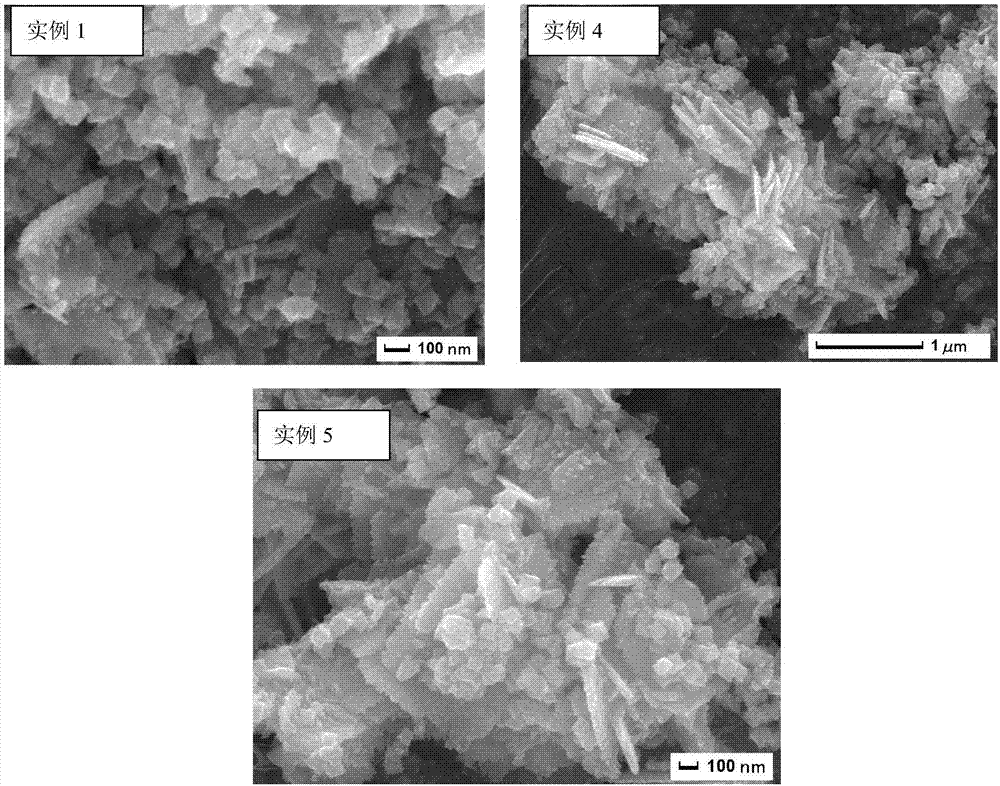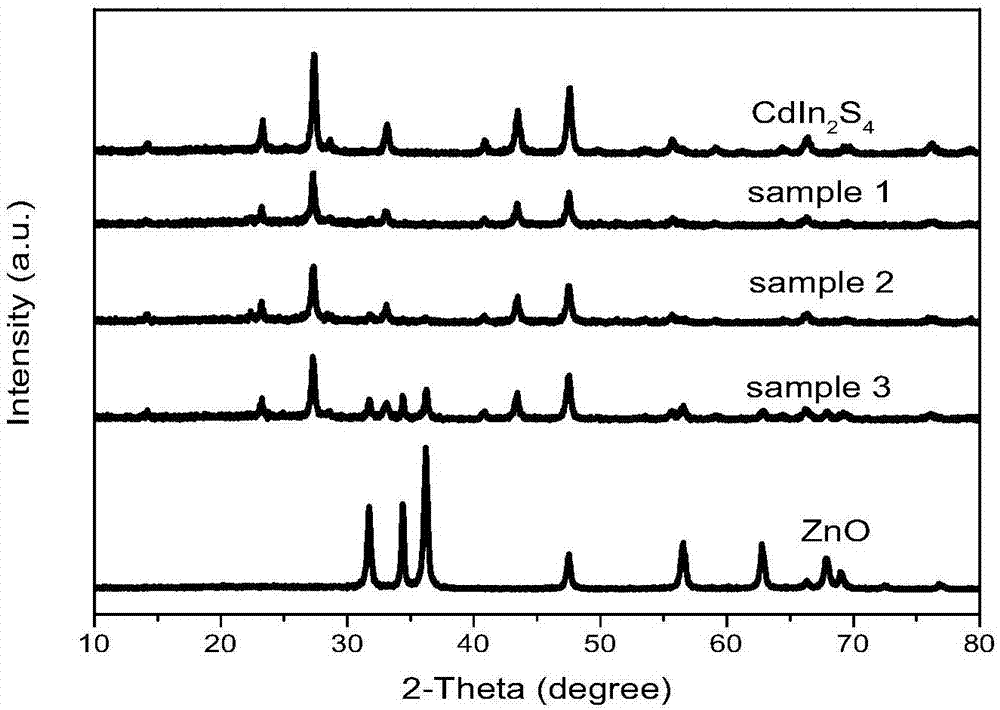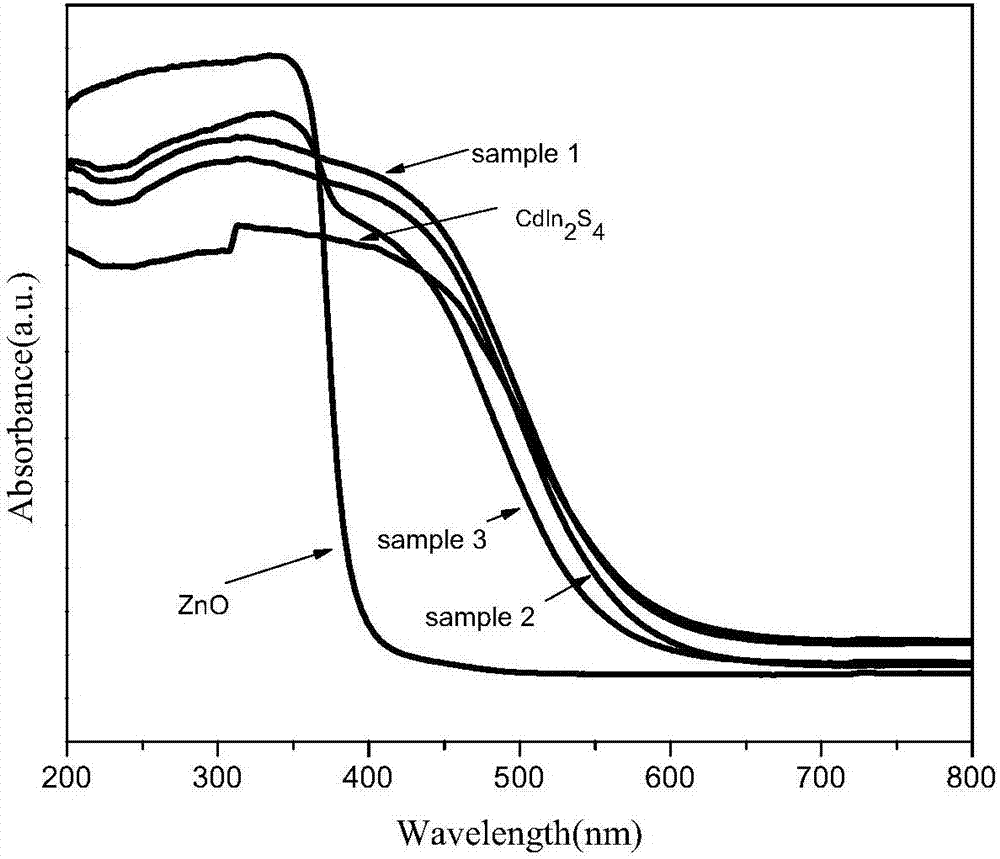Preparation method and application of ZnO-loaded CdIn2S4 nano-cube composite catalyst
A technology of cubes and composite light, applied in physical/chemical process catalysts, chemical instruments and methods, chemical/physical processes, etc., to achieve the effect of strong light-harvesting ability, excellent solar photocatalytic degradation ability, and large specific surface area
- Summary
- Abstract
- Description
- Claims
- Application Information
AI Technical Summary
Problems solved by technology
Method used
Image
Examples
Embodiment 1
[0034] (1) Measure absolute ethanol and deionized water in a beaker in sequence to obtain 30 mL of ethanol aqueous solution, wherein the volume ratio of absolute ethanol and deionized water is 1:0.5.
[0035](2) Weigh 0.1233g, 0.3056g and 0.2104g of cadmium nitrate, indium nitrate hydrate and thioacetamide respectively, and add them in sequence to the ethanol aqueous solution obtained in step (1). Stir for 10 minutes and sonicate for 5 minutes to form a yellowish solution. Transfer the obtained solution to a polytetrafluoroethylene-lined autoclave for 24 hours at 180 ° C. After the reactor is cooled to room temperature, the solid in the solution is After centrifugation and ultrasonic cleaning with ethanol and water for three times, dry at 80°C for 12 hours to synthesize CdIn 2 S 4 The nano cube is 0.187g, and the side length of the cube is 50-100nm.
[0036] (3) Weigh 0.06g CdIn 2 S 4 Add nanocubes to 10ml of deionized water, and sonicate for 10 minutes to obtain CdIn 2 S...
Embodiment 2
[0044] (1) Sequentially measure absolute ethanol and deionized water into a beaker to obtain 60 mL of ethanol aqueous solution, wherein the volume ratio of absolute ethanol and deionized water is 1:0.7.
[0045] (2) Weigh 1.233g, 3.056g and 2.104g of cadmium nitrate, indium nitrate hydrate and thioacetamide respectively, and add them in sequence to the aqueous ethanol solution obtained in step (1). Stir for 15 minutes and sonicate for 10 minutes to form a yellowish solution. Transfer the obtained solution to a polytetrafluoroethylene-lined autoclave for 28 hours at 180°C. After the reactor is cooled to room temperature, the solid in the solution is After centrifugation and ultrasonic cleaning with ethanol and water for three times, dry at 80°C for 12 hours to synthesize CdIn 2 S 4 The nano cube is 1.87g, and the side length of the cube is 50-100nm.
[0046] (3) Weigh 0.5g CdIn 2 S 4 Add nanocubes into 50ml deionized water, and ultrasonicate for 15min to obtain CdIn 2 S 4...
Embodiment 3
[0053] (1) Sequentially measure absolute ethanol and deionized water into a beaker to obtain 90 mL of ethanol aqueous solution, wherein the volume ratio of absolute ethanol and deionized water is 1:0.8.
[0054] (2) Weigh 2.466g, 6.112g and 4.208g of cadmium nitrate, indium nitrate hydrate and thioacetamide respectively, and add them to the aqueous ethanol solution obtained in step (1) in sequence. Stir for 20 minutes and sonicate for 15 minutes to form a yellowish solution. Transfer the obtained solution to a polytetrafluoroethylene-lined autoclave for 32 hours at 180 ° C. After the reactor is cooled to room temperature, the solid in the solution is After centrifugation and ultrasonic cleaning with ethanol and water for three times, dry at 80°C for 12 hours to synthesize CdIn 2 S 4 The nano cube is 3.74g, and the side length of the cube is 50-100nm.
[0055] (3) Weigh 1.5g CdIn 2 S 4 Add nanocubes to 100ml of deionized water, and sonicate for 20 minutes to obtain CdIn 2 ...
PUM
 Login to View More
Login to View More Abstract
Description
Claims
Application Information
 Login to View More
Login to View More - R&D
- Intellectual Property
- Life Sciences
- Materials
- Tech Scout
- Unparalleled Data Quality
- Higher Quality Content
- 60% Fewer Hallucinations
Browse by: Latest US Patents, China's latest patents, Technical Efficacy Thesaurus, Application Domain, Technology Topic, Popular Technical Reports.
© 2025 PatSnap. All rights reserved.Legal|Privacy policy|Modern Slavery Act Transparency Statement|Sitemap|About US| Contact US: help@patsnap.com



